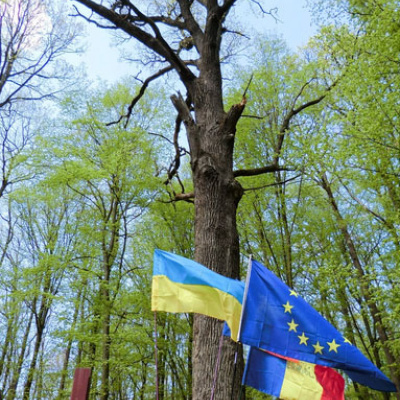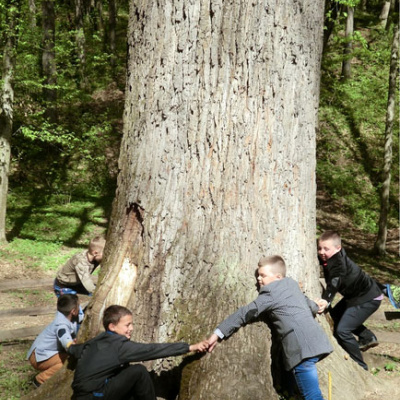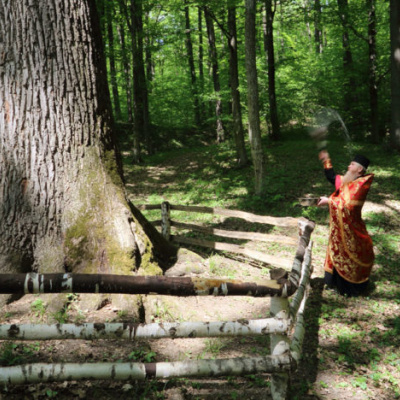Oak by Stefan cel Mare, Valya Kuzmina
The oak tree growing in the territory of the Klishkovets forestry(Hlyboka district) is more than 515 years old. The historic oak tree, which is more than half a millennium old and is said to have been planted by Moldovan voivode Stefan the Great, grows in the Valya-Kuzmin forestry. In late summer, small yellowish balls can often be seen on the leaves of the oak tree. Their appearance is caused by a small insect that lays eggs in this way. Growths form in the place of bitten leaves. These balls were called ink nuts and were used to make ink.
Thus, the main local attraction of Valia-Kuzmina is this old oak of the Moldovan ruler Stefan the Great (Ştefan cel Mare). The oak is in the forest, the path to it is trodden. For the local predominantly Romanian-speaking population, the oak is truly a relic. According to legend, the tree, which is definitely over 500 years old, was planted by Stefan after the glorious victory over the Polish-Lithuanian army of King Jan Olbrecht.
Jan I Olbrecht dreamed of putting his brother Sigismund on the throne of Moldova: Moldova was seen as a convenient springboard for future wars with Turkey. The Polish army numbered about 60-80 thousand people, of whom 5 to 10 thousand were nobles of the Polish-Lithuanian Commonwealth and the GDL. At first, everything seemed to be going well: Jan Olbracht's men laid siege to the fortress in Suceava, where Stephen the Great was hiding. The siege lasted for four months-but did not bring results. Diseases began in the Polish camp. When Jan Olbracht's army marched through the mountains toward their homes, Stefan cel Mare and his men (about 22 thousand soldiers) attacked them near the forest of boyar Kozmin. The 5000 well-armed nobles immediately fell into a trap: their armor and horses were good helpers on the battlefield, but in the forest... Oh. Horses can't turn around here.
According to legend, the Moldovans, most of whom did not have armor, let alone weapons, began cutting down trees in the forest, throwing them at the enemy, dividing the Polish army into small, unconnected units, and killing them. The Polish nobles killed with sticks and branches, not swords. Those Poles and Lithuanians who survived fled across the Prut River toward Lviv. Others were either killed or taken prisoner. Later, Stefan III ordered the battlefield to be cleared and planted with an oak tree (the same one, the Red Oak). Of the oaks planted by the Poles, only one allegedly remained, the one that now bears the name of the ruler of Moldova.
Stefan was sure that he had lost at least half of his men in the forest fight, but, again, according to legend, the Moldovan losses were minimal. Although among the wounded near Kozmyn was Stefan's son and heir, the future ruler Bohdan Slipyj, who lost his eye when a Polish nobleman speared him with a spear. The boyars who were with Bohdan during the incident allegedly said that the blinded young man continued to fight, although he was screaming in pain (I have no idea how true this information is). Among the trophies captured by the Moldovans in the battle were the military banners of Krakow, Lviv, and Sandomierz, as well as 9 flags of smaller cities and several flags of noble families. Jan Olbracht himself was not present at the battle, he immediately went to Lviv without even stopping for the night. Although he had two more years of reign ahead of him, he is remembered as the king for whom the color of the Polish gentry died.
Romanians have long dreamed of erecting a monument to Stefan cel Mare near Val Kuzmin. The water in Val Kuzmyn is valuable, mineral and even medicinal. The same old couple who gave me a ride through Vala Kuzmyn on a cart told me that until 1949, the part of the village from the church to the memorial was called Codra Valea Kozminului (codra means forest).
Along the former Austrian-Romanian border, trenches and pillboxes have been preserved that covered the narrow-gauge railroad that ran through the Bukovyna forests in those days. On the outskirts of the village, towards Bila Krynytsia, there is a cemetery-memorial to the soldiers who died in the First World War. In 1936, when Bukovyna was under Romanian rule, with the assistance of the Austrian government, the soldiers who had fallen in other parts of the region were reburied here. It was around that time that the memorial took on the form we see today. There is a column with a cross in the center, four graves on its sides, and plaques with the names of the dead behind it.




